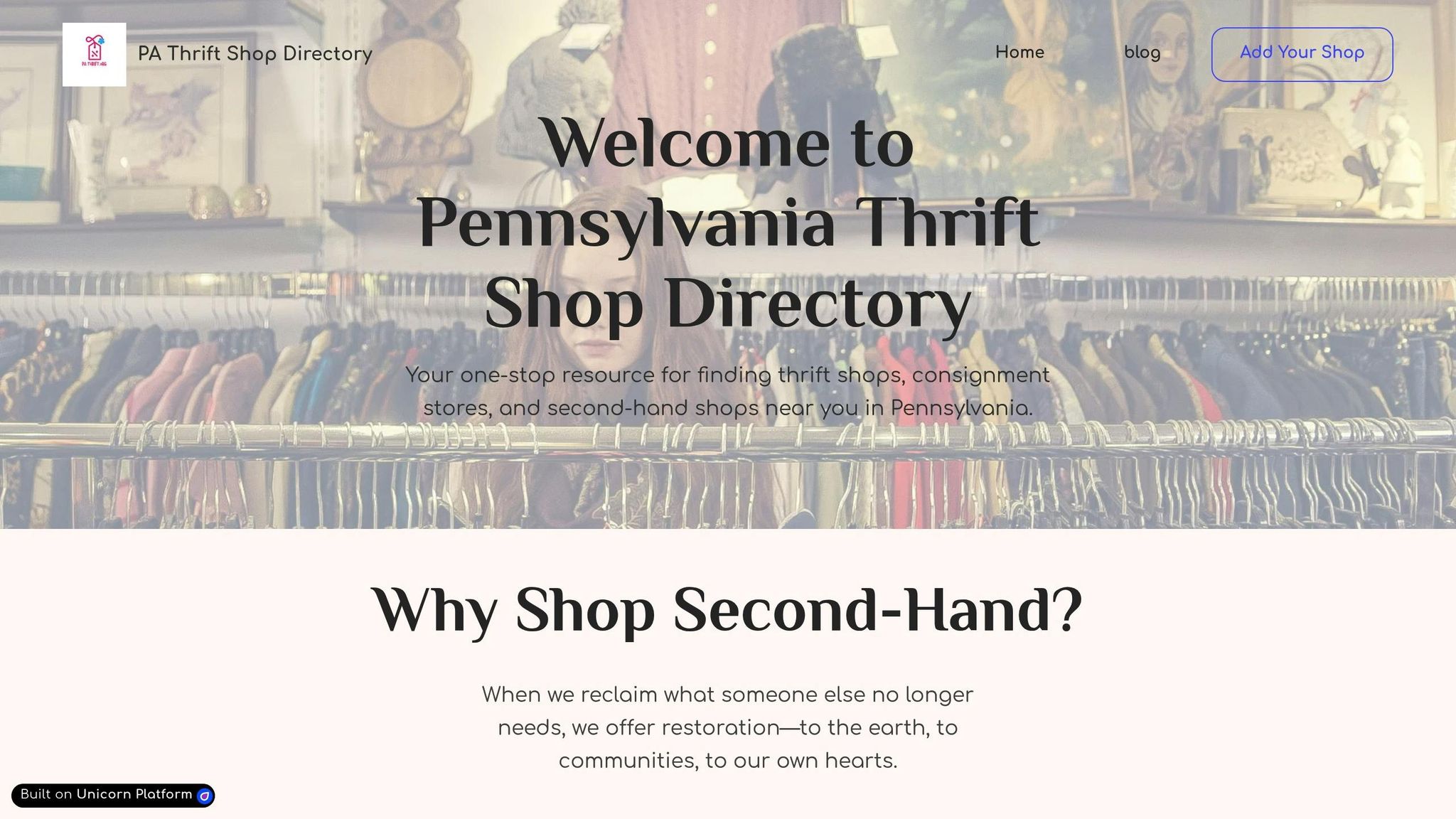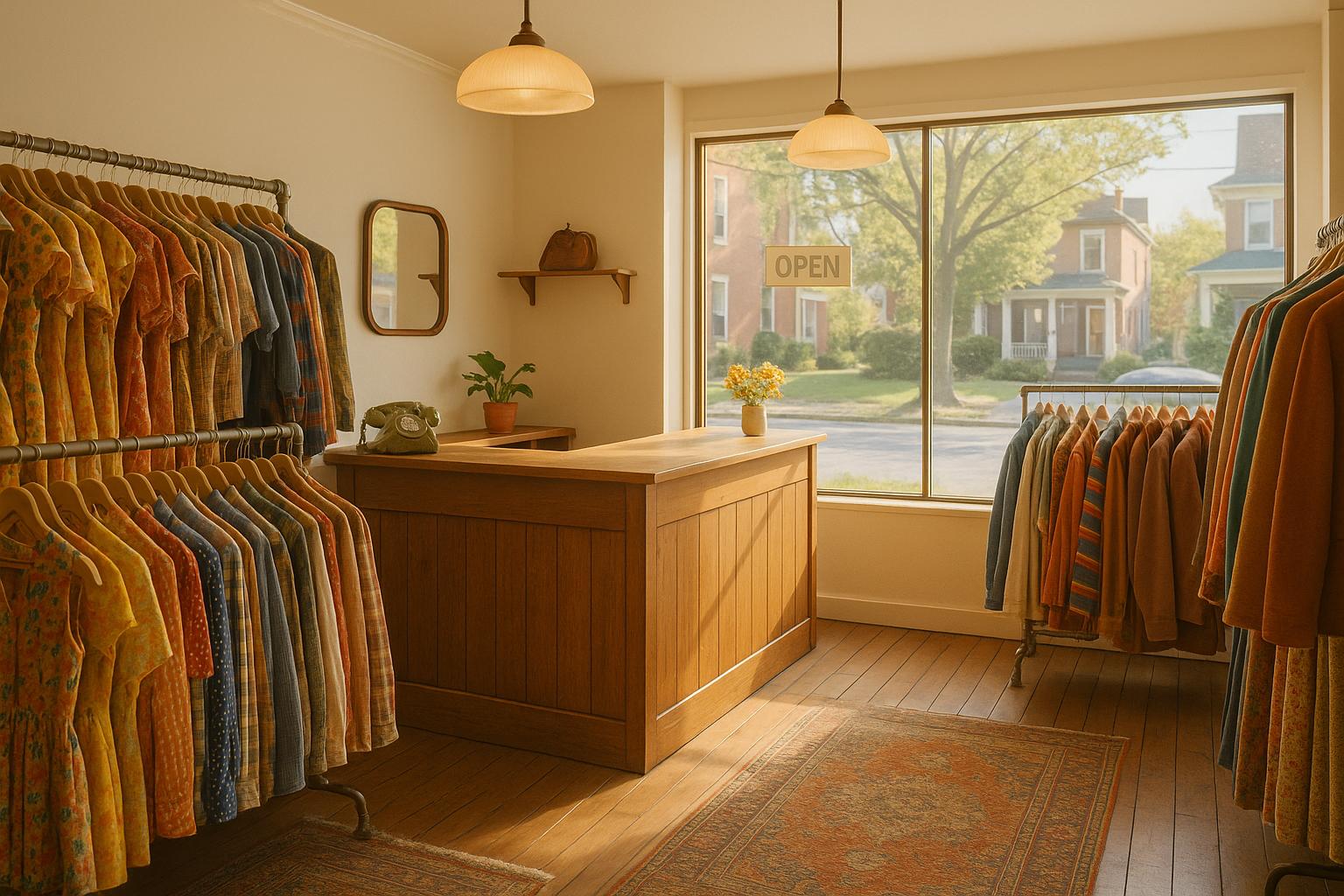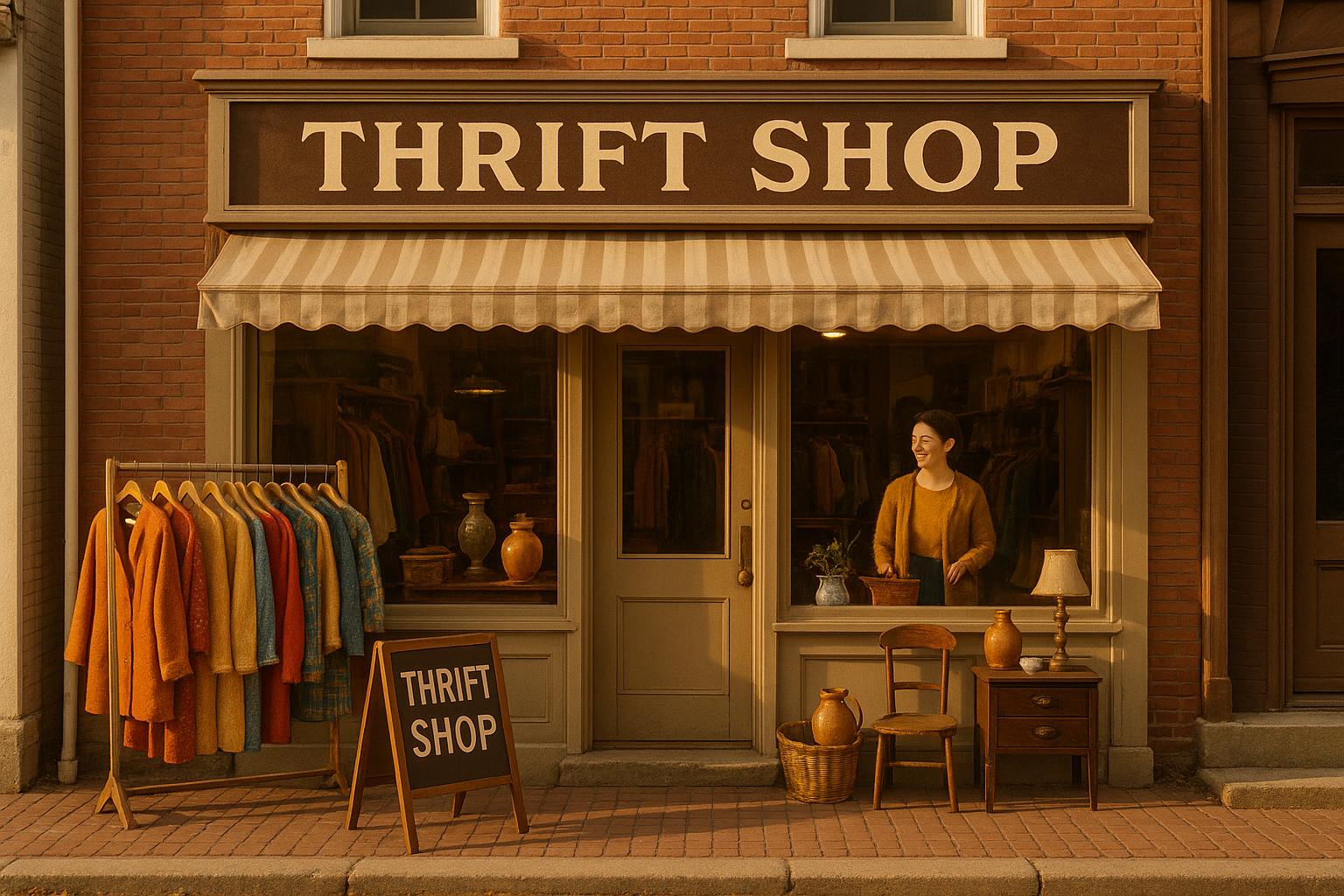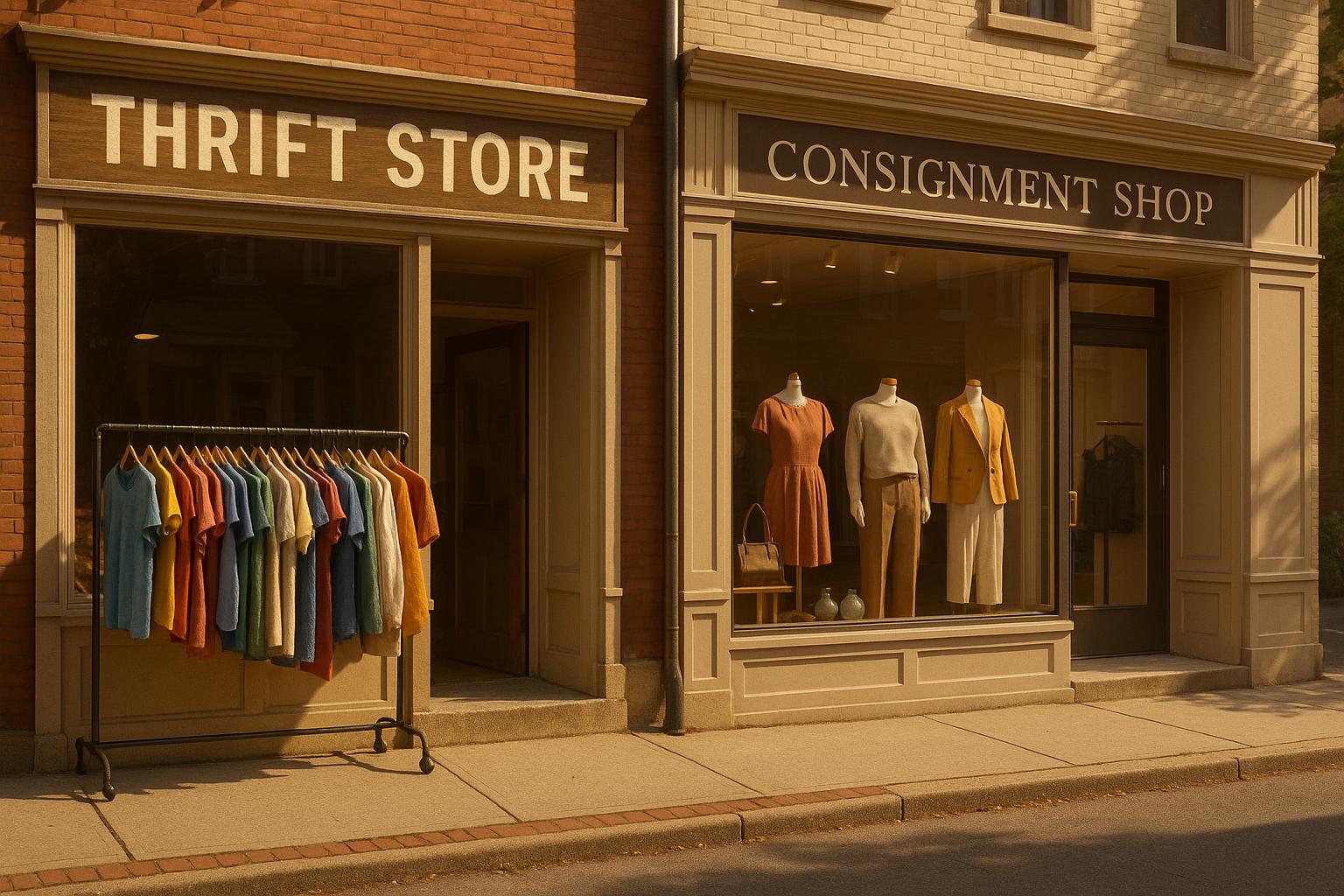Thrift shopping for vintage clothing is a mix of saving money, reducing waste, and finding timeless, well-made pieces. Vintage clothing - typically 20+ years old - offers styles and craftsmanship that stand out from modern fast fashion. To make the most of your thrift trips, focus on:
- Understanding Vintage: Look for items at least 20 years old, not retro (modern inspired) or reproductions (modern copies).
- Types of Stores: Explore thrift shops (budget-friendly), consignment stores (curated), vintage boutiques (higher-end), and estate sales (hidden treasures).
- Preparation: Research fashion trends by decade, bring tools like a magnifying glass and smartphone for label checks, and plan your route with tools like PaThrift.
- Spotting Quality: Check fabric (natural fibers like wool or silk), construction (tight stitching, metal zippers), and labels (union or designer tags).
- Condition: Inspect for stains, odors, and repair needs. Some issues, like moth holes, can be deal-breakers.
The ULTIMATE GUIDE to THRIFTING VINTAGE (+How to make modern clothes LOOK vintage!)
What Is Vintage Clothing and Why Shop for It?
Knowing what qualifies as vintage clothing can turn aimless thrift store visits into intentional treasure hunts. The world of secondhand fashion is vast, and understanding its categories can help you uncover unique finds while staying within your budget.
What Counts as Vintage?
Vintage clothing generally includes items that are at least 20 years old, though collectors often prefer pieces that are 30 years or older due to their historical and aesthetic value. Clothing from the 1960s through the 1980s is especially sought after because of its rarity and the craftsmanship of the era.
It’s important to differentiate vintage from retro and reproduction clothing. Retro garments are modern creations inspired by past styles, while reproductions are contemporary copies of vintage designs. Unlike genuine vintage, these newer pieces often lack the original construction techniques, high-quality materials, and historical significance that make authentic vintage so special.
The appeal of vintage goes beyond its age. It’s also about sustainability and the unique designs that stand out in a world of mass production.
Why Choose Vintage Clothing?
Shopping vintage is a great way to reduce waste while enjoying the benefits of superior craftsmanship. Older garments often feature hand-finished details, reinforced stitching, and high-quality materials that modern fast fashion simply can’t match. For instance, a wool coat from the 1960s might still be in excellent condition today, outlasting several newer alternatives.
Vintage clothing also brings individuality to your wardrobe. Imagine wearing a dress from 1975 - its charm and character are unmatched by today’s mass-produced collections. Timeless silhouettes like A-line dresses, tailored blazers, or classic trousers not only add a unique flair but also serve as enduring wardrobe staples.
These qualities make exploring Pennsylvania's secondhand stores an exciting and rewarding experience.
Types of Secondhand Stores in Pennsylvania
Pennsylvania offers a variety of secondhand shopping options, each catering to different budgets and preferences:
- Thrift Shops: Typically run by nonprofits or charities, thrift stores offer affordable clothing priced between $3 and $15. While inventory changes frequently and finding gems may take effort, the low prices make it worth the hunt.
- Consignment Stores: These shops sell clothing on commission, resulting in a curated selection of higher-quality items. Prices generally range from $20 to $80, reflecting the better condition and style of the pieces.
- Vintage Boutiques: Specializing in authentic vintage, these boutiques offer carefully curated collections. While prices are higher - often $40 to $200 or more - the quality and authenticity are usually guaranteed.
- Estate Sales and Church Rummage Sales: These events can be goldmines for vintage lovers. Entire wardrobes spanning decades are often available at reasonable prices, and you might even discover exceptionally well-preserved items.
To simplify your vintage shopping in Pennsylvania, tools like PaThrift can be a game-changer. Instead of driving around aimlessly, you can search for stores by location, type, or even specific items. This saves both time and gas money, ensuring you focus on the best spots for your budget and style. By understanding the types of stores available, you’ll be better equipped to find vintage treasures that match your preferences.
How to Prepare for Your Thrift Shopping Trip
Thrift shopping, especially for vintage treasures, starts well before you step into the store. With a little research, the right tools, and a solid plan, you can turn a casual outing into a productive adventure. Here’s how to gear up for your next thrifting trip.
Research Trends and Time Periods
Knowing the hallmarks of different decades can make spotting authentic vintage items much easier. Vintage clothing typically refers to pieces from the 1920s to the 1990s, while anything pre-1920 is considered antique, and retro refers to modern reproductions inspired by older styles.
Each era has its own unique look and construction details that can help you identify genuine vintage pieces:
- 1920s: Flapper dresses with dropped waists
- 1930s: Bias-cut dresses that highlight natural curves
- 1940s: Structured shoulders with triangular pads and puffed or darted sleeves
- 1950s: Hourglass silhouettes with cap or raglan sleeves
- Late 1960s–1970s: Bell sleeves and relaxed, flowing designs
Even small details like zippers can offer clues. For instance, metal zippers on the side or back are common in older garments, while plastic zippers are more typical of later decades.
What to Bring With You
Preparation is key to making the most of your thrift shopping trip. Here are some essentials to pack:
- Magnifying glass: Great for inspecting fabric quality, stitching, or labels.
- Smartphone: Load it with helpful apps for identifying vintage pieces or bookmark reliable vintage fashion websites for quick reference.
- Notebook and pen: Use these to jot down store names, addresses, pricing, and any standout finds. Keeping a record can guide future trips and help you build rapport with store staff.
- Cash (in small bills): Many thrift stores prefer cash, and having exact change can save time during checkout, especially in busier shops.
Your smartphone can also double as a research tool to verify designer names or estimate price ranges on the spot, ensuring you make informed decisions.
Find Thrift Shops Using PaThrift

PaThrift is a fantastic resource for finding thrift and resale shops across Pennsylvania that specialize in vintage clothing. This directory allows you to focus your energy on the most promising locations, saving both time and effort.
When browsing listings, look for phrases like "vintage clothing", "curated vintage," or "antique fashion." For example, Fifty One Ten Vintage in Pittsburgh lists offerings such as "Men's & Women's Curated American Vintage Clothing from 1970s - 2000 Vintage T Shirts, Denim, Crewnecks Hoodies and more". These descriptions give you a clear idea of what to expect before you even step inside.
To avoid wasted trips, call ahead to confirm store hours and inventory, as these can change frequently. If possible, plan a route that includes several shops in the same area to maximize your chances of finding unique pieces. With your research done, tools packed, and route planned, you’ll be ready to dive into the world of vintage shopping and uncover some incredible finds.
How to Spot High-Quality Vintage Pieces
Once you’ve done your research and gathered the right tools, the next step is to focus on the details that separate true vintage gems from less desirable finds. Inside a thrift shop, knowing what to look for can make all the difference.
Check Fabric and Construction Quality
Start with the fabric - it’s one of the best indicators of a garment’s age and quality. Older vintage pieces often use natural fibers like wool, silk, cotton, or linen. These materials tend to feel more substantial compared to the thinner, flimsier fabrics often found in modern fast fashion. Take a moment to touch the garment; the weight and texture can tell you a lot.
Next, inspect how the piece is constructed. Look for hand-stitched details, even and tight stitching, and flat seams. These are hallmarks of well-made vintage clothing. Closures and hardware also provide clues - metal zippers (commonly found on the side or back), covered buttons, or hook-and-eye closures are typical of older garments. Keep in mind that plastic zippers became more widespread in later decades, so a metal zipper can hint at an earlier production date.
Don’t forget to check the lining. High-quality vintage dresses and jackets often feature full linings made from materials like silk or acetate. Details such as French seams or bound seams add a polished, clean finish to the inside of the garment, further signaling quality craftsmanship.
Once you’ve assessed the fabric and construction, move on to examining the labels for more clues about the piece’s origin and authenticity.
Read Labels and Tags
Labels are like a garment’s fingerprint, offering insights into its age, origin, and overall quality. Look for union labels, "Made in USA" tags, or designer labels. Union labels, such as those from the International Ladies' Garment Workers' Union (ILGWU) or the Amalgamated Clothing Workers of America, can be particularly helpful in dating a piece.
Designer labels are another strong indicator of value. Pieces from early collections of renowned designers like Halston, Diane von Furstenberg, or Calvin Klein are worth paying attention to. Even department store labels from high-end retailers like Saks Fifth Avenue or Lord & Taylor can signify a well-made vintage find.
One thing to note: many vintage garments lack detailed care instruction labels, as these weren’t standardized in earlier decades. If you come across a piece with modern-style care instructions in multiple languages, it’s likely from a more recent era.
Check Condition and Repair Needs
Before committing to a purchase, take a close look at the garment’s overall condition. Even the most beautiful vintage piece may not be worth it if it’s too damaged or requires extensive repairs. Examine the item under good lighting to spot stains, discoloration, or fading that might be impossible to fix.
Pay attention to odors as well. Some smells, especially musty or mildew-like scents, can be extremely difficult to remove completely.
Check the seams for strength by gently tugging on them. Look for missing buttons, broken zippers, or snagged threads. Original buttons are often unique and can be hard to replace, so their condition matters. Be especially vigilant with wool pieces - moth holes and insect damage are common issues. While minor flaws can sometimes be repaired by a skilled tailor, severe damage can significantly reduce the piece’s value.
Finally, consider whether the garment can be altered to fit you properly. Vintage sizing is often different from modern standards, but some pieces have generous seam allowances that make alterations easier. Others may not leave much room for adjustments, so be mindful of the potential tailoring challenges.
sbb-itb-b3bf950
Tools and Methods for Verifying Vintage Clothing
Once you've carefully inspected a garment, the next step is to confirm its authenticity using digital tools and a keen eye for design. With the right resources and knowledge, you can confidently determine whether a piece is truly vintage or not.
Use Fashion Guides and Apps
Your smartphone can be a powerful ally when it comes to identifying vintage clothing. Google Lens, for instance, is a handy tool for recognizing labels and designers instantly. Just point your camera at a label, and the app will pull up similar images and relevant information online. This can help you figure out if you're holding a rare designer piece or something more common.
Another invaluable resource is the Vintage Fashion Guild Label Resource, an online database that catalogs thousands of vintage clothing labels from different time periods. Accessible on your phone, it allows you to cross-check labels while shopping. The database includes details like company operation dates, label designs from various eras, and other key identifiers.
For more in-depth research, reference books like "Vintage Fashion: Collecting and Wearing Designer Classics" by Emma Baxter-Wright or "Warman's Handbags" by Abigail Rutherford are excellent choices. These guides feature detailed photos and descriptions of authentic vintage pieces, making them great tools for understanding specific styles and eras.
Social media platforms like Pinterest and Instagram can also be incredibly useful. Searching hashtags such as #1960sfashion or #vintagedior provides visual examples of authentic pieces from specific decades or designers. These visual cues can help you train your eye to recognize hallmark details of vintage construction and styling. Use these insights to quickly date garments and identify features unique to each time period.
Identify Features from Different Decades
Every decade has its own distinct fashion trends, which can help you pinpoint the era of a garment. Here are some hallmark features from different time periods:
- 1950s: Cinched waists, structured bodices, and full skirts
- 1960s: A-line silhouettes, bold mod patterns, and geometric designs
- 1970s: Flowing bohemian styles, bell sleeves, and earthy tones
- 1980s: Oversized shoulder pads, vibrant colors, and metallic accents
- 1990s: Relaxed grunge styles, slip dresses, chokers, and minimalist designs
For the 1990s, it's worth noting the rise of designer diffusion lines, which offered more affordable pieces from major fashion houses. These items often reflect the decade's minimalist and edgy aesthetic.
Tell Vintage from Retro and Reproduction
Knowing the difference between authentic vintage, retro-inspired, and reproduction pieces is essential when shopping. This knowledge helps you avoid overpaying for modern items that mimic vintage styles. Here's a breakdown of the key distinctions:
| Category | Age | Construction | Labels | Cost |
|---|---|---|---|---|
| Vintage | 20+ years old | High-quality fabrics, hand-finished details, period-accurate construction | Union labels, older tags, minimal care instructions | $15-$200+ |
| Retro | Modern (0-10 years) | Modern fabrics and construction, inspired by vintage styles | Current brand labels, detailed care instructions | $10-$80 |
| Reproduction | Modern | May mimic vintage construction but varies in quality | "Inspired by" or reproduction brand labels | $20-$150 |
Authentic vintage pieces will often show signs of age, such as wear consistent with their era. The materials, stitching, and hardware should align with the time period, and sizing will typically run smaller compared to today's standards.
Retro clothing, on the other hand, is newly made but draws inspiration from vintage styles. These garments often use contemporary fabrics and construction techniques. While they may replicate vintage aesthetics, their quality and value can vary widely.
Reproduction pieces are designed to look like vintage clothing but are brand new. Brands like Hell Bunny and Collectif produce high-quality reproductions that capture the essence of vintage styles. While these garments can be beautiful, they shouldn't be priced the same as authentic vintage items.
To spot modern reproductions, pay attention to fabric blends that weren't used in earlier decades. For example, spandex became common in the 1980s, so a "1950s" dress with spandex is likely a reproduction. Similarly, modern stretch denim is quite different from the rigid denim found in vintage jeans.
The more you practice, the better you'll get at distinguishing genuine vintage from retro and reproduction items. It's a skill that sharpens over time, helping you make smarter, more informed purchases.
Get the Most from Thrift Shopping in Pennsylvania
Thrift shopping in Pennsylvania can be a treasure hunt if you plan wisely and tap into local knowledge. A little preparation and strategy can make all the difference in finding those hidden gems.
When to Visit Thrift Shops
Timing is everything when it comes to snagging the best finds. Here’s how to make your visits count:
- Arrive early: Be one of the first through the door to get first dibs on newly stocked items.
- Ask about restock schedules: Store staff often know when fresh inventory hits the floor - don’t hesitate to ask.
- Shop during seasonal transitions: End-of-season clear-outs can lead to one-of-a-kind discoveries.
By timing your visits right, you’ll increase your chances of walking away with something special.
Build Relationships with Store Staff
A little friendliness can go a long way. Chatting with store employees and showing genuine interest might earn you insider tips, like when the best items are stocked or which sections to check for hidden treasures. Being polite and approachable can turn staff into your secret allies.
Join the Local Vintage Community
Local vintage groups, whether online forums or in-person meetups, are goldmines for tips and recommendations. These communities often share information about upcoming sales, hidden gems, and the best places to shop. Pair their advice with the resources on PaThrift, and you’ll have a well-rounded strategy.
Plan with PaThrift
PaThrift is an invaluable tool for planning your thrift shopping adventures. It offers detailed store listings, helping you map out efficient routes and find shops that fit your style and budget. Whether you’re looking for vintage clothing, furniture, or quirky collectibles, PaThrift makes it easy to tailor your trip to your preferences.
Conclusion: Start Your Vintage Thrift Shopping Journey
Shopping for vintage clothing at thrift stores is more than just a shopping trip - it's an adventure that blends sustainability, individuality, and savings. Vintage pieces, typically defined as clothing that's at least 20 years old, offer a level of craftsmanship and character that stands the test of time. With this understanding, you're ready to dive into your treasure hunt.
Preparation and patience are your best allies. Before heading to the shops, take some time to explore fashion trends from previous decades, learn what defines high-quality garments, and familiarize yourself with authentic vintage labels from well-known brands. A great resource for this is the Vintage Fashion Guild’s extensive label archive, which can help you verify the authenticity of your finds. Once you're in the store, rely on your inspection skills - look for solid construction and details that indicate quality. These steps will help you make informed choices as you browse.
Thrift shopping is all about persistence. While a little wear can add charm to vintage pieces, avoid items with major damage in areas like elbows or underarms, as these can make them unwearable.
To enhance your shopping experience, consider using tools like PaThrift. This app can help you plan efficient shopping routes throughout Pennsylvania, discover hidden gems in upscale neighborhoods, and time your visits to align with seasonal transitions when stores often refresh their inventory. Plus, building relationships with local shop staff and connecting with the vintage community can turn casual browsing into a more focused and rewarding experience.
Shopping for vintage clothing is about more than just updating your wardrobe. It’s a way to preserve fashion history, embrace sustainable practices, and curate a collection that’s uniquely yours. Every vintage piece carries a story and a level of quality that’s hard to find in modern clothing. So, grab your tools, download your favorite authentication app, and start exploring Pennsylvania’s thrift shops with confidence. Who knows? Your next great find might just be waiting for you.
FAQs
How can I tell if a piece of clothing is authentic vintage or a modern reproduction when thrift shopping?
When identifying authentic vintage clothing, it's all about the details. Start by examining the stitching, labels, and construction. Genuine vintage pieces often showcase hand-stitched seams or neatly finished edges. Labels can be a giveaway too - look for fonts, brand names, or designs that match the era. Even closures like metal zippers, hook-and-eye fastenings, or decorative buttons can hint at a specific time period.
Next, take a close look at the fabric quality. Vintage garments often show subtle signs of age, like natural fading or wear, which add to their charm. Keep an eye out for special touches like French seams, hand-sewn hems, or intricate embellishments - details that are rarely found in modern reproductions. On the other hand, reproductions often rely on modern fabrics, machine stitching, and generic labels, making them easier to spot with a trained eye.
If you're still unsure, dive into some research. Study fashion trends from the decade in question or use vintage guides and apps to cross-check details. Most importantly, trust your gut and take your time. A thorough inspection can help ensure you're bringing home a true vintage gem.
What are the must-have tools and tips for finding authentic vintage clothing while thrifting?
For a successful vintage thrift shopping trip, having a smartphone on hand can make all the difference. It’s your go-to tool for researching era-specific styles, checking labels, and diving into vintage fashion guides. You can even use apps that help verify the authenticity of vintage items. Resources like label databases and guides on evaluating stitching, fabric, and craftsmanship are invaluable for spotting quality pieces.
When browsing, focus on fabric quality and the design details that reflect the era you’re drawn to. Doing a bit of homework ahead of time will help you recognize authentic vintage items more easily and curate a wardrobe that’s both timeless and sustainable.
How can I tell if a vintage garment is in good condition before buying it?
When considering a vintage garment, start by giving the fabric a thorough once-over. Look for any stains, holes, or thinning areas that could affect its longevity. Check that all zippers, buttons, and fastenings are in working order - fixing these can quickly add to your expenses. Pay close attention to the stitching and seams, ensuring they’re intact and sturdy.
While some wear, like gentle fading or a natural patina, can enhance a vintage piece’s charm, steer clear of items with major damage that might be costly or tricky to repair. Not sure about the fabric’s condition? Gently rub a damp cloth on a hidden spot to test for color fastness. Spending a few extra moments on these checks can lead you to timeless, well-preserved vintage finds.


